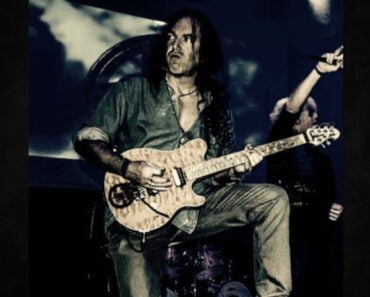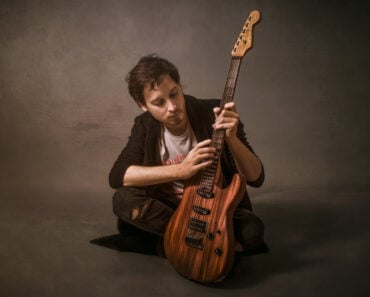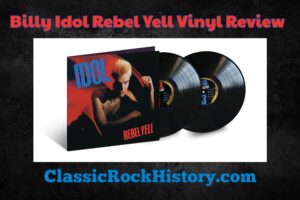
Feature Photo courtesy of Charlie Starr
Some say rock is dead, but one run through Blackberry Smoke’s discography, which includes modern-day classics like Bad Luck Ain’t No Crime (2003), The Whippoorwill (2012), and Find a Light (2018), immediately tells a different story. Led by the perpetually smiling, always laid back, and usually vintage guitar-toting Charlie Starr, Blackberry Smoke combines the hard-driving nature of groups like Led Zeppelin and the Black Crowes while injecting heaping doses of jam band tendencies like the Allman Brothers and raggedy blues ala any of the Chicago greats you’ve known and loved.
But that’s not all—there are modern touches throughout Blackberry Smoke’s music, as evidenced by their latest, Be Right Here, due February 16, 2024. As for how things kicked off, Starr tells ClassicRockHistory.com, “I spoke with [producer] Dave Cobb because it was starting to feel like it was time to make a new record.”
Starr continues, “Dave said, ‘I’m ready for you. If you are, do you have some songs?’ I said, ‘Yeah,’ and told him I had about 15 songs. And then he said, ‘Hey, man, let’s make a little amp album. Let’s find the weirdest little amps we’ve got; let’s use [Fender] Champs and [Fender] Princeton’s, and we could have these little Supros like the little Supros that Jimmy Page loved and a couple of Magnatones.'”
As for how Cobb’s “little amp album impacted Starr’s approach, he says, “Well, Dave said, ‘Don’t bring anything bigger than a 10” speaker;’ he wanted to make an album full of eight-inch speakers. He had just gotten some old vintage compressors, and he’s like, ‘I’m gonna use these things and make the guitar sound huge!’”
He explains, “The smaller speakers just record so well and have such a voice. So, that’s what we did. We went in and went back into Studio RCA in Nashville and picked ten of our favorite songs out of 15. We then went down to his place in Savannah, Georgia; he has another studio there and did all the overdubs that needed to be done and everything there, and then we mixed it in Atlanta, at West End Sound. I’m thrilled with the way it turned out!”
It seems that not only are Blackberry Smoke, along with a few brave others, saviors of rock ‘n’ roll but also forever perpetrators of vintage recording techniques, which is fine, as that style certainly lends itself to Starr’s vibe.
As for how he views himself these days within the context of Blackberry Smokes’ new music, Starr laughs, saying,” That’s a tricky question; maybe ‘Dig a Hole’ represents me best. I don’t know why other than it’s mean. I’m feeling mean these days. I guess that’s age creeping up on me—I’m getting grumpy. We’ll call it my “get off my lawn song” for my “get off my lawn” phase [laughs]!
Charlie Starr: The ClassicRockHistory.com Interview

Photo courtesy of Charlie Starr
You’ve said Be Right Here is your “little amp album.” Little amps have a specific sound and vibe; how does that influence the gear choices you pair with those amp?
It only made a little difference. One of Dave’s reasons for the little amps is that Dave had wanted the amps and the drums and everyone in the room with us. We didn’t have any separation at all. Just some gobos [go-between sound panels] and some soundproofing foam here and there to try to keep too much bleed away from the drum mics, but we just let it go.
It created a feeling just having the drums in there because we tracked the last album in the same place, but we had the drums in a drum booth. It was fantastic having everybody in the room and all the amps. Dave did the same thing with Slash when he made his album there last year. That was something that he had been toying with, just utilizing that big room at RCA. Dave is an analog guy. There’s no click, and there’s no auto-tune or anything. So, he’s like, “Don’t fu*k up. Here we go!”
How do you choose the best ten songs?
I don’t know how you would choose the best because it’s such a debatable idea, a bunch of people’s opinions. You have to instill so much trust in a producer when you agree to work with one, and I trust Dave implicitly, but that’s not to say that we don’t have our own opinions because we sometimes butt heads.
Everybody agreed that the songs we chose are the best for this album. Another exciting thing Dave brought up when we were about to go in, he said, “Don’t show the guys the two songs yet.” He wanted to capture everybody’s first reaction to the song. He tried to capture that spontaneity, so we did that on four of the songs, and it was cool.
What inspires you to write the riffs and solos?
It takes a little more time because you’re not rehearsed on something and prepared, but it does lend itself a little more excitement. This way, it turns it into a Bob Dylan session. That’s the way he made those three amazing records, Bringing It All Back Home, Highway 61 Revisited, and Blonde on Blonde; that’s kind of the way he would operate them was that he was the only person who knew how these songs go and there’s no chance to rehearse, it’s just, “123 go!”
Is that the same approach you’ve used before, or is it entirely new?
It’s new; we’ve always been prepared and rehearsed, and we’ll work on arrangements ourselves because we’ve made so many self-produced records. Pre-production is the production when you make your record, so everybody in the band was excited by the idea. We only said something about it once we got there. We got there and mentioned that there were more songs, and they were like, “Well, how do they go?”
As the ten songs were fleshed out, were there any musical and lyrical themes that kept cropping up?
I’m not sure about musically, but lyrically, I’ll usually look back and think, “Okay, well, this time, I was thinking about a specific idea a lot.” I think this time “luck” rears its head quite a bit. A thread of luck is woven through the songs.
As a lyricist, neither myself nor other guys I like to co-write with go into a project with any idea as far as the theme. Every time, in our case, it’s just accidental. One of my good friends said these songs seem much happier than the last batch, and I said, “Are they? I don’t know, maybe so, but if they are, that wasn’t the intent.”
Do your riffs inspire lyrics or vice versa?
It varies. Sometimes it’s one, sometimes it’s the other. It just depends on whether a guitar is nearby.
Is there a particular guitar you leaned on more often than others while writing and recording these tracks?
Most of the songs were written on a Martin 1950 D-28. It just happened to be a guitar that was in my office every day. A few riffs came from other places, so that would be another guitar. At the very least, the editing process happened on that guitar in my house.
You’ve made it clear in the past that you love vintage guitars. Did any of your favorites make it onto the record?
There’s a Les Paul Jr, a 1965 Gibson ES-330 that I’ve played on every record since I got it in 2014, and it is my favorite recording guitar. It’s on so many songs and records. It just really loves to be recorded. There’s a 1958 Sunburst Telecaster that’s rarely used, and it’s on several songs, and, of course, that 1950 D-28 that I mentioned earlier is used quite a bit.
You’re often seen with the Les Paul Jr, and you mentioned the ES-330, which are very different guitars with different personalities. What’s your take on connecting with certain guitars?
I can feel the personality when I pick a guitar up and strum a G chord, and it’s pretty much instantaneous. As soon as you strum, it’s just a vibration that your body feels with that guitar, you know, while it’s vibrating, and if you hit that G chord just right, it’s like, “Wow, okay, well, this thing has a voice, and I hear it already, even before it’s plugged into anything.”
What about that ES-330 resonated with you?
I’m not sure, really. I’d never owned a 330 before acquiring this one, and I’ve had to buy it because I borrowed one from Brendan O’Brien when we made the fourth album with him, and I fell in love with his, and I said, “Man, this guitar is an animal!” and he said, “Yes, it is because they’re completely hollow.”
They’re not like an ES-335, which is semi-hollow, whereas the 330 is entirely hollow, so they’re dangerous around an amplifier because they’ll take off with you. I use that, and I use his guitar on a few songs on that album and say, “Well, you have to sell me this guitar.” He’s like, “Bullshit. I don’t have to; I love it; go get your own.”
I went and found one, and he said, “You want the year ’64, ’65, early ’65 before the nuts got re-done, and they also have the middle pickup covers, and that’s what you want because that’s part of the recipe.” He was right, so I had a friend help me find this one.
The 330 is always the rescue guitar if I’m struggling with a song with another guitar. When I’m working on something that just isn’t clicking, I’ll go, “You know what, it’s going to need to have that damn 330!” and it wins every time. It’s got P90s, a tremendous, big single-coil pickup, but it’s got a thicker, fatter humbucker-type feel. That guitar is just so woody and round and large sounding.
How does your approach change when you have a Telecaster in your hands versus that 330, for example?
Well, the 330 is just not a lead guitar; it’s got a short-scale neck, and the neck meets the body at the 12th fret, and the Telecaster is just a different animal. I know it’s hard to put into words.
Where do you pull inspiration from most while writing?
These days, it comes from experience and what we’ve absorbed musically, all of us. It might be something we have listened to recently, or it might be the idea of soloing. I can tell when something I’m writing needs to be another verse, or another bridge, or another voice, so many times with solos, I’ll play the song’s melody and start with that.
Out of the ten songs that made it onto Be Right Here, which one proved the most meaningful?
That’s hard to say. Well, I’d written the song with my friend Travis Meadows called “Azalea,” which contains the lyric poem “Will Always be Right Here,” so that’s where the album’s title came from, which seemed to hit home.
After what my drummer Brit [Turner] has gone through with his health in the last year, he’s been through so much with a heart attack and brain surgery and cancer treatment; it’s been so very surreal. That one may hit home the most for me.
What are you most excited about as you move forward, and what’s next for Blackberry Smoke?
We’ll put this record out into the world and try to play it live for as many people as humanly possible. We’ve never been to Japan, so we definitely want to go to Japan. We want to return to South America, as we’ve only been to South America once on tour and everywhere else our path typically hits. See you all out there.
Dont forget to check out the band’s new album Right Here
An Interview With Charlie Starr Of Blackberry Smoke article published on Classic RockHistory.com© 2024
Classicrockhistory.com claims ownership of all its original content and Intellectual property under United States Copyright laws and those of all other foreign countries. No one person, business, or organization is allowed to re-publish any of our original content anywhere on the web or in print without our permission. All photos used are either supplied by the artists, public domain Creative Commons photos, or licensed officially from Shutterstock under license with ClassicRockHistory.com.




































